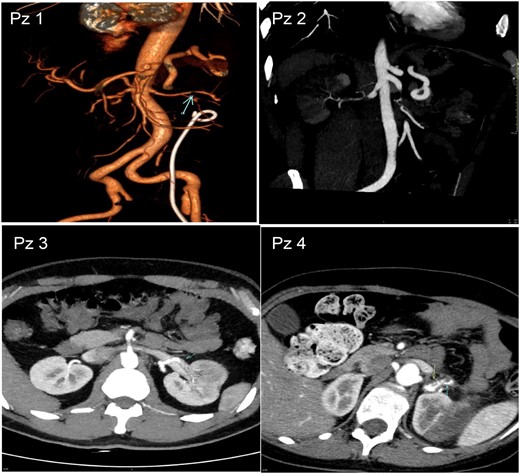-
PDF
- Split View
-
Views
-
Cite
Cite
Fausta Catapano, Maria Cristina Galaverni, Simone NIcoletti, Elena Mancini, MO173
SPONTANEOUS RENAL ARTERY DISSECTION (SRAD): IS IT REALLY SO RARE?, Nephrology Dialysis Transplantation, Volume 36, Issue Supplement_1, May 2021, gfab092.0051, https://doi.org/10.1093/ndt/gfab092.0051Close - Share Icon Share
Abstract
Spontaneous Renal Artery Dissection (SRAD) is a rare and often unrecognized clinical entity, which only accounts for 1-2% of all arterial dissections. Due to its rarity, it may be difficult to diagnose and treat.
All patients affected by SRAD and admitted in our Unit in the last year were included.
Five patients presented with renal infarction due to SRAD were admitted in our Unit in 2020. Patient Characheristics are shown in Table 1. At onset, all suffered from abdominal pain and high blood pressure. In all patients renal function was normal. Abdomen computed tomography angiography (CTA) was diagnostic in all patients (Figure 1). They were treated with antihypertensive drugs and systemic anticoagulation followed by oral anticoagulants. At 3 month-follow-up, all patients became normotensive and partial or total renal artery recanalization were found (Figure 2).


| Patient . | Sex . | Age (years) . | Blood Pressure (mmHg) . | SRAD . | Comobidities . | Cerebral MRI/CT . |
|---|---|---|---|---|---|---|
| 1 | F | 61 | 150/100 | Left segmental branch anterior inferior and Right renal artery | Kidney stones | negative |
| 2 | M | 49 | 150/90 | Right renal artery | Severe cardiovascular familiarity, GIST | negative |
| 3 | M | 39 | 140/90 | Left segmental antero-inferior renal artery | Severe cardiovascular familiarity, OFP ostium II | negative |
| 4 | F | 51 | 145/85 | Left renal artery | Dolicocolon | Carotid-oftalmic aneurism |
| 5 | M | 50 | 150/100 | Right and left renal artery | Family history for tumors | negative |
| Patient . | Sex . | Age (years) . | Blood Pressure (mmHg) . | SRAD . | Comobidities . | Cerebral MRI/CT . |
|---|---|---|---|---|---|---|
| 1 | F | 61 | 150/100 | Left segmental branch anterior inferior and Right renal artery | Kidney stones | negative |
| 2 | M | 49 | 150/90 | Right renal artery | Severe cardiovascular familiarity, GIST | negative |
| 3 | M | 39 | 140/90 | Left segmental antero-inferior renal artery | Severe cardiovascular familiarity, OFP ostium II | negative |
| 4 | F | 51 | 145/85 | Left renal artery | Dolicocolon | Carotid-oftalmic aneurism |
| 5 | M | 50 | 150/100 | Right and left renal artery | Family history for tumors | negative |
| Patient . | Sex . | Age (years) . | Blood Pressure (mmHg) . | SRAD . | Comobidities . | Cerebral MRI/CT . |
|---|---|---|---|---|---|---|
| 1 | F | 61 | 150/100 | Left segmental branch anterior inferior and Right renal artery | Kidney stones | negative |
| 2 | M | 49 | 150/90 | Right renal artery | Severe cardiovascular familiarity, GIST | negative |
| 3 | M | 39 | 140/90 | Left segmental antero-inferior renal artery | Severe cardiovascular familiarity, OFP ostium II | negative |
| 4 | F | 51 | 145/85 | Left renal artery | Dolicocolon | Carotid-oftalmic aneurism |
| 5 | M | 50 | 150/100 | Right and left renal artery | Family history for tumors | negative |
| Patient . | Sex . | Age (years) . | Blood Pressure (mmHg) . | SRAD . | Comobidities . | Cerebral MRI/CT . |
|---|---|---|---|---|---|---|
| 1 | F | 61 | 150/100 | Left segmental branch anterior inferior and Right renal artery | Kidney stones | negative |
| 2 | M | 49 | 150/90 | Right renal artery | Severe cardiovascular familiarity, GIST | negative |
| 3 | M | 39 | 140/90 | Left segmental antero-inferior renal artery | Severe cardiovascular familiarity, OFP ostium II | negative |
| 4 | F | 51 | 145/85 | Left renal artery | Dolicocolon | Carotid-oftalmic aneurism |
| 5 | M | 50 | 150/100 | Right and left renal artery | Family history for tumors | negative |
In our experience, SRAD seems to be not very rare in young and healthy patients with minimal comorbidities. Abdomen CTA is one of the “gold standard” non invasive diagnostic method. In patient treated with conservative medical therapy renal outcome is favourable. More studies are necessary to find underlying causes.
- anticoagulation
- antihypertensive agents
- anticoagulants, oral
- hypertension
- abdominal pain
- renal function
- renal artery
- aneurysm
- blood pressure
- cardiovascular system
- comorbidity
- diagnostic techniques and procedures
- tissue dissection
- kidney calculi
- abdomen
- diagnosis
- kidney
- neoplasms
- nephrolithiasis
- recanalization
- gastrointestinal stromal tumor
- renal infarction
- computed tomographic angiography
- brain mri
- gold standard
- left renal artery
- right renal artery
- medical management





Comments